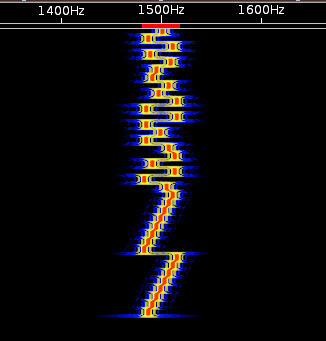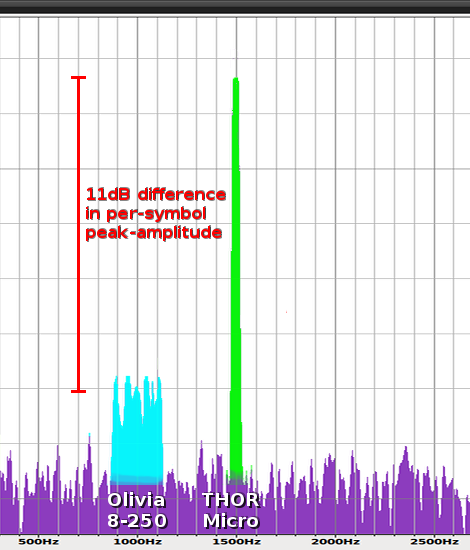Table of Contents
THOR Micro is a new soundcard based digital mode designed for the 2200 meter, 600 meter, 160 meter, and higher amateur radio bands.
This new mode is:
- More robust than Olivia ( perfect copy at -18db SNR )
- As narrow as PSK31 ( 36 Hz bandwidth )
The major limiting factors on the LF and MF amateur radio bands are low radiated power and high noise. Antennas at these low frequencies suffer from very low efficiency and little of the power sent to them is converted into RF.
In order to overcome the low power output at these frequencies, THOR micro's speed is slowed down to 2 baud. This increases the watts/Hz (spectral density) of the transmitted signal, focusing the power into a very-narrow bandwidth.
On the receive side this sharp signal translates into an increased signal-to-noise ratio. Further gain can be achieved by using very-narrow receive filters.
This mode is also a great tool for low-power digital operation, or in place of QRSS.

Signal 36 Hz wide | 
Compared to Olivia 8/250 |
Thor Micro emits a distinctive double rising tone sequence at the beginning of each transmission. It is used to flush the receive decoder and also provides a visual and audible clue to its being used.
The modem code for Thor uses a wide band multiple frequency detector that can lock on and detect the incoming signal even when badly mistuned. Frequency domain oversampling is used to allow proper tone detection without the need for AFC. The AFC control does not alter the decoder in any way.
There is just one mode of THOR micro
| Name | Baudrate | Bitrate | Datarate | FEC |
|---|---|---|---|---|
| THOR Micro | 2 | 8 bits/sec | 4 bits/sec | K=7 @ 1/2 Rate |
Performance
THOR Micro can achieve 100% decode at signal to noise ratios lower than -18dB, which makes it more robust than Olivia. This mode can be decoded properly even when to the human ear, the incoming signal sounds like pure noise.
Such performance is achieved by using a very low baudrate, which increases the spectral density (watts-per-Hz) of the transmitted signal.
The signal to noise ratio (SNR) for any mode is calculated as a ratio of the Energy-per-bit / Noise-Level. For THOR Micro the energy-per-bit (at 25 watts) would be 25 watts X 0.5 seconds, or 12 watt/sec per symbol: 3 watt/sec per bit.
For Olivia 8-250, the lowest SNR Olivia mode: 25 watts X 0.032 seconds or 0.8 watt/sec per symbol: 0.26 watt/sec per bit. The effective Thor Micro signal strength is 11 times that of of the equivalent Olivia signal. THOR Micro uses a 7.5 dB gain soft-decision FEC code.
On the 2200, 630, and 160 meter bands this increase in effective received-signal power helps overcome the massive system losses and high-noise levels encountered when using these low frequencies.
Multi-language UTF-8 Support
THOR Micro supports sending all UTF-8 characters. This means the mode can be used to communicate in any language.
Please ensure the font chosen in Fldigi has the characters for the language you are trying to use, otherwise Fldigi will just display every character as an empty box.
Preamble
A special preamble precedes each THOR micro transmission. It consists of a bit-sequence that is invalid in the normal data stream: a string of 64 zeros. This preamble is the distinctive rising tone sequence that occurs twice before any data modulation.
When received, this preamble triggers the receiver end to flush the long interleaver and the soft-decision viterbi decoder. This flush prepares the viterbi decoder and interleaver for the data about to be received.
Flushing any received noise-bits before decoding the actual signal decreases the probability of error and provides FEC gain. This gain comes from not mixing the good data-bits with bad noise-bits by filling interleaver and soft-decoder instead with punctures.
Forward Error Correction
A constraint length 7 convolutional FEC is used at 1/2 rate. This long constraint-length code gives a free distance of 10 (can correct a 4-bit error). The coding gain is about 7.5 dB.
2.5 dB of soft-decision coding-gain has been added to all coding-gain calculations .
IFK+ Modulation
THOR Micro uses a modulation scheme known as Incremental Frequency Keying Plus (IFK+). It is very similar to 18-tone MFSK modulation, but with many benefits.
Using IFK+ modulation is what allows THOR Micro to achieve it's very-narrow bandwidth. IFK+ modulation is much easier to tune than an MFSK signal of the same baudrate. For MFSK, a signal must be tuned to an accuracy of baudrate / 3. This results in an accuracy requirement of less than 1 Hz (at 2 baud).
The tuning accuracy requirement of IFK+ is bandwidth / 2. This is about 18Hz for a 2 baud IFK+ signal. This tuning can easily be achieved by manually clicking on the signal in the waterfall display, just like a PSK31 signal, or by presetting the receiver to within +/- 18 Hertz of the target frequency.
IFK+ is a differential-type MFSK modulation where the data-bits are encoded as the frequency difference between the previous tone and the next tone.
Number (bits) to be sent: 3 (0011)
Previous tone: 4 (0100)
Transmitted tone: 3 + 4 + 2 = 9 (1001)
Since there are only 18-tones in THOR micro, the number simply wraps around back to 0 when it reaches number 19.
The current tone always has 2 added before transmitting. This introduces a known pattern within the signal that benefits soft-decision decoding, boosts the forward error correction, and improves resistance to intersymbol interference.
Interleavers
Even though the THOR Micro interleaver is quite short in bitcount, the mode's slow baudrate spreads the bits over a long timeframe.
| Mode | Bits | Msec |
|---|---|---|
| THOR Micro | 16 | 1500 |
From the perspective of "number of bits": it is a short interleaver.
From the perspective of "number of milliseconds": it is a long interleaver.
Constraint Length 7 FEC details:
constraint length = 7
polynomial 1 octal: 0155
polynomial 2 octal: 0117
polynomial 1 decimal: 109
polynomial 2 decimal: 79
Interleaver Details:
4x4 self synchronizing
1500 milliseconds